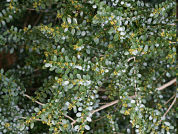Factores que modelan el patrón de minación de hojas en el arbusto Azara microphylla
DOI:
https://doi.org/10.25260/EA.16.25.3.0.166Resumen
La actividad de los herbívoros puede depender tanto de las características de los recursos como de las interacciones con otros organismos que dañan las hojas. Analizamos el efecto de la dureza de la hoja y la probabilidad de daño foliar sobre el recorrido y la eficiencia de las larvas del minador de hojas en el arbusto Azara microphylla. En comparación con el sector apical, el sector basal de las hojas fue más duro y mostró una probabilidad menor de daño foliar por herbívoros, hongos y/o patógenos. Los minadores tuvieron una actividad mayor en el sector basal, a pesar de que, en general, comenzaban su recorrido en el sector apical (que fue el sitio de mayor oviposición). La eficiencia resultó similar en ambos sectores foliares. Estos resultados sugieren que las interacciones con otros organismos que dañan las hojas cumplen un papel relevante en modelar la actividad forrajera de los minadores e ilustran cómo las construcciones que realizan los individuos pueden ser empleadas para estudiar su ecología y su comportamiento.
Citas
BAIRSTOW, K; K CLARKE; M MCGEOCH & N ANDREW. 2010. Leaf miner and plant galler species richness on Acacia: relative importance of plant traits and climate Oecologia, 163:437-448.
BÖHM, SM; K WELLS & EKV KALKO. 2011. Top-Down Control of Herbivory by Birds and Bats in the Canopy of Temperate Broad-Leaved Oaks (Quercus robur). PLOS ONE, 6:e17857. doi:10.1371/journal.pone.0017857.
BULTMAN, T & S FAETH. 1986. Effect of within-leaf density and leaf size on pupal weight of a leaf-miner, cameraria (lepidoptera: gracillariidae). The Southwestern Naturalist, 31:201-206.
CHOONG, MF. 1996. What makes a leaf tough and how this affects the pattern of Castanopsis fissa leaf consumption by caterpillars. Functional Ecology, 10:668-674.
COLEY, PD & JA BARONE. 1996. Herbivory and plant defenses in tropical forests. Annual Review of Ecology and Systematics, 27:305-335.
CORNELISSEN, T & P STILING. 2008. Clumped distribution of oak leaf miners between and within plants. Basic and Applied Ecology, 9:67-77.
CUAUTLE, M & V RICO-GRAY. 2003. The effect of wasps and ants on the reproductive success of the extrafloral nectaried plant Turnera ulmifolia (Turneraceae). Functional Ecology, 17:417-423.
DENNO, RF; MS MCCLURE & JR OTT. 1995. Interspecific interactions in phytophagous insects: competition re-examined and resurrected. Annual Review of Entomology, 40:297- 331.
DIRZO, R & C DOMÍNGUEZ. 1995. Plant-herbivore interactions in Mesoamerican tropical dry forests. Pp. 304-345 in: Bullock, S; S Mooney & E Medina (eds.). Seasonally dry tropical forests. Cambridge University, Massachusetts.
DOMÍNGUEZ, CA; R DIRZO & SH BULLOCK. 1989. On the function of floral nectar in Croton suberosus (Euphorbiaceae). Oikos, 56:109-114.
FISHER; A; SE HARTLEY & M YOUNG. 1999. Behavioural responses of the leaf-chewing guild to the presence of Eriocrania mines on silver birch (Betula pendula). Ecological Entomology, 24:15-162
FISHER; A; SE HARTLEY & M YOUNG. 2000. Direct and indirect competitive efects of foliage feeding guilds on the performance of the birch leaf-miner Eriocrania. Journal of Animal Ecology, 69:165-176.
HOWARD, JJ. 1987. Leaf-cutting and Diet Selection: Relative Influence of Leaf Chemistry and Physical Features. Ecology, 69:250-260.
KAPLAN, I & RF DENNO. 2007. Interspecific interactions in phytophagous insects revisited: a quantitative assessment of competition theory. Ecology Letters, 10:977-994.
KARBAN, R. 1986 Interspecific competition between folivorous insects on Erigeron glaucus. Ecology, 67:1063-072.
LUCAS, PW; IM TURNER; NJ DOMINY & N YAMASHITA. 2000. Mechanical defenses to herbivory. Ann. Bot., 86:913-920.
MARQUIS, RJ & CJ WHELAN. 1994. Insectivorous birds increase growth of white oak through consumption of leaf-chewing insects. Ecology, 75:2007-2014.
MCARTHUR, C; P BANKS; P BOONSTRA; R JENNIF & J FORBEY. 2014. The dilemma of foraging herbivores: dealing with food and fear. Oecologia, 176:677-689.
RZANNY, M; A KUU & W VOIGT. 2012. Bottom-up and top-down forces structuring consumer communities in an experimental grassland. Oikos, 122:967-976.
SINCLAIR, R & L HUGHERS. 2012. Leaf miners: The hidden herbivores. Austral Ecology, 35:300-313.
TEAFORD, MF; PW LUCAS; PS UNGAR & KE GLANDER. 2006. Mechanical Defenses in Leaves Eaten by Costa Rican Howling Monkeys (Alouatta palliata). American Journal of Physical Anthropology, 129:99-104.
THOMPSON, J. 1998. Evolutionary ecology of the relationship between oviposition reference and performance of offspring in phytophagous insects. Entomologia Experimentalis et Applicata, 47:3-14.
TURNER, JS. 2000. The Extended Organism: The Physiology of Animal-Built Structures. Harvard University Press, Cambridge, Massachusetts.
YAMAZAKI, K & S SUGIURA. 2008. Deer predation on leaf miners via leaf abscission. Naturwissenschaften, 95:263-268.
ZAR, JH. 1999. Biostatistical Analysis. Prentice-Hall. London. Pp. 717.

Descargas
Archivos adicionales
Publicado
Cómo citar
Número
Sección
Licencia
Derechos de autor 2016 Laila D. Kazimierski, Alejandro Farji-Brener

Esta obra está bajo una licencia Creative Commons Reconocimiento 3.0 Unported.
Las/os autoras/es conservan sus derechos de autoras/es: 1) cediendo a la revista el derecho a su primera publicación, y 2) registrando el artículo publicado con una Licencia de Atribución de Creative Commons (CC-BY 4.0), lo que permite a autoras/es y terceros verlo y utilizarlo siempre que mencionen claramente su origen (cita o referencia incluyendo autoría y primera publicación en esta revista). Las/os autores/as pueden hacer otros acuerdos de distribución no exclusiva siempre que indiquen con claridad su origen, así como compartir y divulgar ampliamente la versión publicada de su trabajo.


